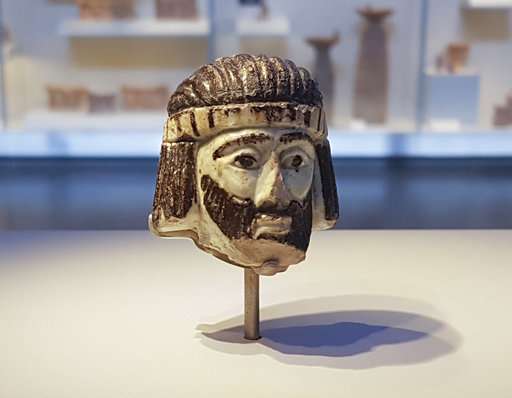An enigmatic sculpture of a king’s head dating back nearly 3,000 years has set off a modern-day mystery caper as scholars try to figure out whose face it depicts.
The 5-centimeter (2-inch) sculpture is an exceedingly rare example of figurative art from the Holy Land during the 9th century B.C. — a period associated with biblical kings. Exquisitely preserved but for a bit of missing beard, nothing quite like it has been found before.
While scholars are certain the stern bearded figure wearing a golden crown represents royalty, they are less sure which king it symbolizes, or which kingdom he may have ruled.
Archaeologists unearthed the diminutive figurine in 2017 during excavations at a site called Abel Beth Maacah, located just south of Israel’s border with Lebanon, near the modern-day town of Metula.
Nineteenth-century archaeologists identified the site, then home to a village called Abil al-Qamh, with the similarly named city mentioned in the Book of Kings.
During the 9th century B.C., the ancient town was situated in a liminal zone between three regional powers: the Aramean kingdom based in Damascus to the east, the Phoenician city of Tyre to the west, and the Israelite kingdom, with its capital in Samaria to the south.
Kings 1 15:20 mentions Abel Beth Maacah in a list of cities attacked by the Aramean King Ben Hadad in a campaign against the Israelite kingdom.
“This location is very important because it suggests that the site may have shifted hands between these polities, more likely between Aram-Damascus and Israel,” said Hebrew University archaeologist Naama Yahalom-Mack, who has headed the joint dig with California’s Azusa Pacific University since 2013.
Yahalom-Mack’s team was digging through the floor of a massive Iron Age structure in the summer of 2017 when a volunteer who arrived for the day struck pay dirt. The layer where the head was found dates to the 9th century B.C., the epoch associated with the rival biblical kingdoms of Israel and Judah.
In a rare move, archaeologists and curators at the Israel Museum in Jerusalem rushed to put the piece on public display. A detailed report is set for publication in the June edition of the journal Near Eastern Archaeology.
Eran Arie, the Israel Museum’s curator of Iron Age and Persian archaeology, said the discovery was one of a kind. “In the Iron Age, if there’s any figurative art, and there largely isn’t, it’s of very low quality. And this is of exquisite quality.”
The royal figurine is made of faience, a glass-like material that was popular in jewelry and small human and animal figurines in ancient Egypt and the Near East.
“The color of the face is greenish because of this copper tint that we have in the silicate paste,” Yahalom-Mack said. But a crucial clue for identifying it as a Near Eastern monarch was its “very interesting hairdo,” she said.
The bearded figure’s hair is pulled back in thick locks that cover the ears, and is held in place by a striped diadem of gold. Its hairstyle looks similar to the way ancient Egyptians depicted neighboring Near Eastern peoples in art.
“The guy kind of represents the generic way Semitic people are described,” she said.
Because Carbon-14 dating cannot give a more exact date for the statue’s creation other than sometime in the 9th century, the field of potential candidates is large. Yahalom-Mack posited it could be kings Ben Hadad or Hazael of Damascus, Ahab or Jehu of Israel, or Ithobaal of Tyre, all characters appearing in the biblical narrative.
“We’re only guessing here, it’s like a game,” she said. “It’s like a hello from the past, but we don’t know anything else about it.”
As scholars debate whether the head was a stand-alone piece or part of a larger statue, the Hebrew University team is set to restart digging this month at the spot where the mystery king’s head was found.
(AP)












5 Responses
@ywn B.C means Before Christ. Your supposed to write BCE (before common era)
“Yahalom-Mack’s team was digging through the floor of a massive Iron Age structure in the summer of 2017 when a volunteer who arrived for the day struck pay dirt. The layer where the head was found dates to the 9th century B.C., the epoch associated with the rival biblical kingdoms of Israel and Judah.”
us religious jews call it bce so as not to be mamlich avodah zara
Highly unlikely to be king, or even Jewish. That sort of sculpture (a graven image by any standard) is not found among Jews. It isn’t like they have found other such realistic statues in Jewish archeological sites. As the article said, it just a generic middle eastern head, not easily dateable and reflecting Egyptian art styles.
Notice the source of the article. AP. A leading purveyor of politically correct “fake news”.
Akuperma answered the first two posters
All Ywn did was copy and paste an AP article without any changes
The reason the hilonim are claiming it is a Jewish king, is they want to “prove” that the Jews in Biblical times did not hold by Torah and Mitsvos, since a big part of the “party line” of the secular Jews is that the Orthodox Jews invented the idea of Torah and MItsvos recently, and that they (especially the zionists) are returning to an original, mitsva-free, version of Yiddishkeit (which, in this case, held no prohibition against graven images or idols).
It violates the halacha of Lashon Ho’ra for YWN to uncritically reprint AP articles, especially when the articles pertain to Jews.